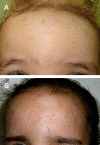Two Egyptian cases of lipoid proteinosis successfully treated with acitretin
- PMID: 24748909
- PMCID: PMC3989095
- DOI: 10.3315/jdcr.2014.1168
Two Egyptian cases of lipoid proteinosis successfully treated with acitretin
Abstract
Background: Lipoid proteinosis (Urbach-Wiethe disease) is a rare progressive autosomal recessive disorder, characterized histologically by deposition of periodic acid Schiff-positive, diastase resistant, hyaline-like material into the skin, upper aerodigestive tract, and internal organs.
Main observation: We report two cases of lipoid proteinosis. A 2-year-old girl presented with vesiculobullous skin lesions on her face, trunk, extremities and scalp, inability to protrude the tongue and hoarseness of voice that appeared few months after birth. The other case is a 4-year-old girl, who presented with waxy papules on face and trunk, hoarseness of voice and enlarged lips and tongue. The lesions healed leaving pitted scars in both cases. Based on clinical, histopathological and laryngoscopy findings, lipoid proteinosis was diagnosed in both cases. Acitretin was started in a dose of 0.5 mg/kg/day in every child. Complete remission of cutaneous lesions and improvement of the hoarseness was observed after one year.
Conclusion: Acitretin may be benificial for treatment of mucosal and cutaneous lesions in lipoid proteinosis.
Keywords: acitretin; blister; genodermatoses; hoarseness; lipoid proteinosis; pharynx; throat.
Figures






Similar articles
-
Lipoid proteinosis in two siblings: a report from south India.Dermatol Online J. 2003 Dec;9(5):12. Dermatol Online J. 2003. PMID: 14996385
-
Lipoid proteinosis: case report and review of the literature.Acta Otorhinolaryngol Ital. 2006 Jun;26(3):162-7. Acta Otorhinolaryngol Ital. 2006. PMID: 17063986 Free PMC article. Review.
-
Lipoid proteinosis (Urbach-Wiethe disease) in two siblings.Indian Dermatol Online J. 2014 Dec;5(Suppl 2):S95-7. doi: 10.4103/2229-5178.146168. Indian Dermatol Online J. 2014. PMID: 25593816 Free PMC article.
-
[Lipoid proteinosis of Urbach-Wiethe: a case report].Dermatol Online J. 2011 Nov 15;17(11):8. Dermatol Online J. 2011. PMID: 22136864 Portuguese.
-
Lipoid proteinosis: report of four siblings and brief review of the literature.Pediatr Dermatol. 2001 Jan-Feb;18(1):21-6. doi: 10.1046/j.1525-1470.2001.018001021.x. Pediatr Dermatol. 2001. PMID: 11207965 Review.
Cited by
-
Ocular manifestations in lipoid proteinosis: A rare clinical entity.Indian J Ophthalmol. 2015 Oct;63(10):793-5. doi: 10.4103/0301-4738.171517. Indian J Ophthalmol. 2015. PMID: 26655007 Free PMC article.
-
Lipoid proteinosis: A rare entity.Indian J Ophthalmol. 2015 Aug;63(8):680-1. doi: 10.4103/0301-4738.169791. Indian J Ophthalmol. 2015. PMID: 26576529 Free PMC article.
-
Esophageal Aperistalsis in a Patient with Lipoid Proteinosis.Middle East J Dig Dis. 2018 Jan;10(1):55-58. doi: 10.15171/mejdd.2017.92. Epub 2018 Jan 14. Middle East J Dig Dis. 2018. PMID: 29682250 Free PMC article.
-
Lipoid Proteinosis: Identification of a Novel Nonsense Mutation c.1246C>T:p.R416X in ECM1 gene from Bangladesh.Pak J Med Sci. 2023 Jul-Aug;39(4):1212-1215. doi: 10.12669/pjms.39.4.7437. Pak J Med Sci. 2023. PMID: 37492299 Free PMC article.
-
Lipoid proteinosis: Unfamiliar skin findings delay diagnosis.JAAD Case Rep. 2018 Jun 28;4(6):609-611. doi: 10.1016/j.jdcr.2018.03.010. eCollection 2018 Jul. JAAD Case Rep. 2018. PMID: 30003130 Free PMC article. No abstract available.
References
-
- Hamada T. Lipoid proteinosis. Clin Exper Dermatol. 2002;27:624–629. - PubMed
-
- Van Hougenhouck-Tulleken W, Chan I, Hamada T, Thornton H, Jenkins T, McLean WH, McGrath JA, Ramsay M. Clinical and molecular characterization of lipoid proteinosis in Namaqualand, South Africa. Br J Dermatol. 2004;151:413–423. - PubMed
-
- Rao R, Prabhu SS, Sripathi H, Gupta S. Vesiculobullous lesions in lipoid proteinosis: a case report. Dermatol Online J. 2008;14:16. - PubMed
-
- Chan I, Liu L, Hamada T, Sethuraman G, McGrath JA. The molecular basis of lipoid proteinosis: mutations in extracellularmatrix protein 1. Exp Dermatol. 2007;16:881–890. - PubMed
-
- Molina-Ruiz AM, Cerroni L, Kutzner H, Requena L. Cutaneous deposits. Am J Dermatopathol. 2014;36:1–48. - PubMed
Publication types
LinkOut - more resources
Full Text Sources
Other Literature Sources
